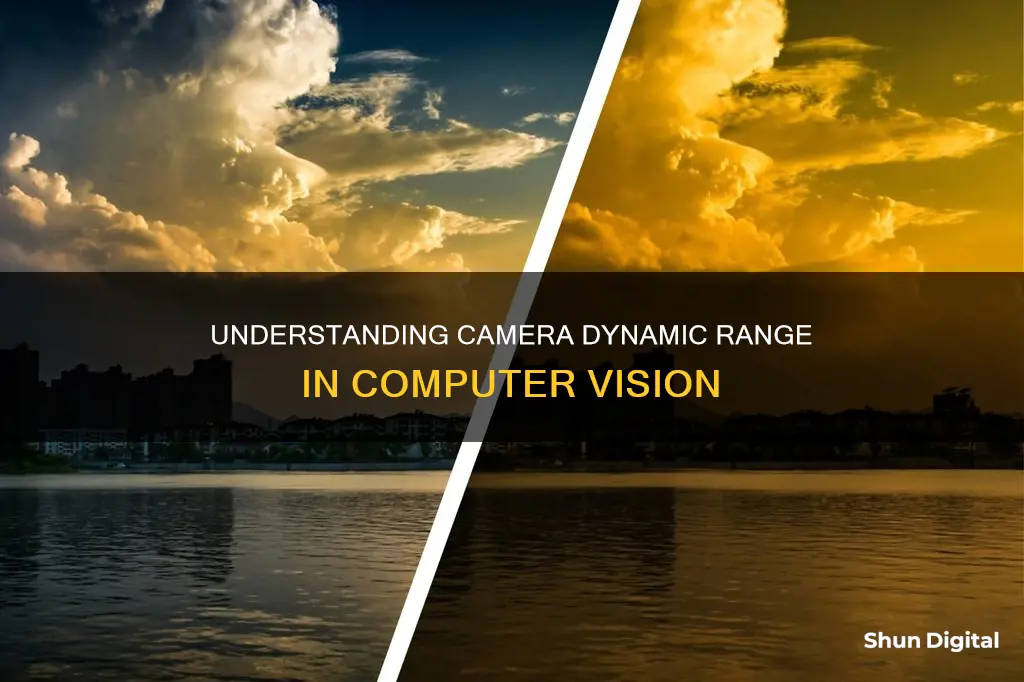
Dynamic range is a fundamental concept in photography and cinematography that describes the ratio between the brightest and darkest spots in an image. In other words, it is the difference between the darkest and lightest tones in an image, generally pure black and pure white. Dynamic range is important because it determines how much detail can be captured within an image. The wider the dynamic range, the greater the amount of detail that can be captured.
| Characteristics | Values |
|---|---|
| Definition | Dynamic range is the ratio between the maximum and minimum values of a varying measurement. |
| Application to Photography | Dynamic range is the ratio between the whitest values (brightest) and darkest values within an image. |
| Measurement | Dynamic range is measured in f/stops or t/stops. |
| Impact on Detail | A high dynamic range typically means that more detail in both highlights and shadows can be captured. A low range means that details in shadows may be lost or details in highlights may be blown out. |
| Impact on Editing | A high dynamic range gives more control over an image when editing. |
| Impact on Lighting | A high dynamic range means less reliance on artificial lighting. |
| Dynamic Range of the Subject | The dynamic range of the subject is a measure of the range of light intensities from the shadows to the highlights. |
| Dynamic Range of the Camera | Different cameras and different sensors will have bigger or smaller dynamic ranges. |
| Impact of Dynamic Range on Exposure | If the subject’s dynamic range exceeds that of the camera, one part of the subject will be either under or over-exposed. |
| Dynamic Range and Histogram | The histogram shows the range of subject brightness starting with black on the left going to white on the right. The width of the histogram chart represents the dynamic range of the camera sensor. |
| Dynamic Range and Exposure Settings | Adjusting the exposure triangle settings of shutter speed, aperture, or ISO will shift an image toward overexposure or underexposure. |
| Dynamic Range and Metering | Metering modes such as evaluative metering, centre-weighted metering, and spot metering can help manage exposure in high-contrast scenes. |
| Dynamic Range and HDR | High Dynamic Range (HDR) photography can be used to increase the dynamic range of an image by combining multiple exposures. |
What You'll Learn

Dynamic range in photography and cinematography
Dynamic range is a fundamental principle in photography and cinematography that allows creatives to bring their vision to life. It is the ratio between the whitest (brightest) and darkest values within an image. In other words, it is the range of light intensities that a medium can record.
In photography and cinematography, dynamic range is what determines the amount of detail that can be captured within an image. It is measured in f-stops or t-stops, with a wider range indicating a greater dynamic range. A high dynamic range means that more detail can be captured in highlights and shadows, while a low dynamic range can result in lost details in shadows or blown-out highlights.
Understanding dynamic range is crucial for photographers and cinematographers as it can help improve the quality of their work. By knowing the dynamic range of their camera, they can make informed decisions about camera settings, scene selection, and film stock choice to achieve optimal contrast and detail levels.
The dynamic range of a camera can vary depending on the type of camera and the size of the image sensor. Digital SLR cameras, for example, generally have a higher dynamic range than compact cameras due to larger pixel sizes. Additionally, the dynamic range of a scene can also vary depending on factors such as lighting conditions and reflectivity.
Dynamic range is not just relevant to photography and cinematography but is also used in audio, tech, and mathematics. However, its application in these fields may differ, and it is important to distinguish its specific use in photography and cinematography.
In summary, dynamic range in photography and cinematography plays a crucial role in capturing detailed and vivid images. It is a technical concept that, when understood and utilised effectively, can enhance the visual quality and creativity of images.
Transferring Camera Files to Your Windows PC
You may want to see also

Dynamic range in audio, tech and mathematics
Dynamic Range in Audio, Tech, and Mathematics
Dynamic range is the ratio between the largest and smallest values that a certain quantity can assume. It is often used in the context of signals like sound and light. In audio, the dynamic range refers to the difference between the loudest and softest passages in a piece of music. Audio gear also has a distinctive dynamic range, which describes the boundaries of what a piece of equipment is capable of producing. This is calculated as the ratio between the loudest sound that a unit can produce and the quietest sound before noise becomes audible.
The human auditory system has a dynamic range of about 90 dB, with healthy hearing capable of perceiving sounds from a whisper (around 30 dB) to a jet taking off (120 dB). The dynamic range of music as normally perceived in a concert hall does not exceed 80 dB, and human speech is typically perceived over a range of about 40 dB.
In digital audio, the dynamic range is limited by quantization error. The maximum achievable dynamic range for a digital audio system with Q-bit uniform quantization can be calculated using a specific formula. Digital audio with 20-bit quantization is theoretically capable of 120 dB dynamic range, while 24-bit digital audio affords 144 dB dynamic range.
In analog audio, the dynamic range is the difference between low-level thermal noise in the electronic circuitry and high-level signal saturation. Early phonograph discs had a dynamic range of up to 40 dB, while vinyl microgroove records typically yield 55-65 dB. Magnetic tape recording technology has achieved dynamic ranges of up to 90 dB, and modern digital audio workstations process audio with 32-bit floating-point representation, providing an even higher dynamic range.
Dynamic range compression is a technique used to fit content with a wide dynamic range into a narrower recorded dynamic range for easier storage and reproduction. This is commonly done in electronically reproduced audio and video.
In mathematics, dynamic range is used in the context of metrology, referring to the range of values that can be measured by a sensor or metrology instrument. The dynamic range of measurement is often limited by saturation at one end and random noise or uncertainty at the other end. When digital sensors are used, the dynamic range is related to the number of binary digits (bits) used in the numeric representation. For example, a 12-bit digital sensor can provide a dynamic range with a ratio of up to 2^12 = 4096 between the maximum and minimum measured values.
In summary, dynamic range is a concept that spans various fields, including audio, technology, and mathematics. It refers to the ratio between the largest and smallest values within a given range, and it plays a crucial role in signal processing, audio equipment, and measurement systems.
Selecting Camera Landscapes: Camera Raw Tips
You may want to see also

Dynamic range of the subject vs camera
Dynamic range is a fundamental concept in photography that describes the ratio between the brightest and darkest parts of an image. It is important to understand the dynamic range of the subject and the camera to get a perfectly exposed photograph.
The dynamic range of the subject is the range of light intensities from the shadows to the highlights. This range varies depending on the lighting conditions and the reflectivity of the objects in the scene. In low-light conditions, the dynamic range is smaller, while on a bright sunny day, the range is much higher and often exceeds the range of the camera.
The dynamic range of the camera refers to its ability to capture the brightest and darkest portions of an image. Different cameras have different dynamic ranges, and this range is determined by factors such as the size of the photosites or pixels. If the dynamic range of the subject exceeds that of the camera, parts of the image will be under or overexposed, resulting in a loss of detail.
To get a perfectly exposed photograph, the dynamic range of the subject should not exceed the dynamic range of the camera. Photographers can use techniques such as bracketing, HDR photography, or graduated neutral density filters to handle high dynamic range scenes and capture more detail in their images.
Additionally, the dynamic range of the display device, such as a computer screen or print, also comes into play when reproducing an image. The human eye has its own dynamic range and can perceive a greater dynamic range than a camera.
Connecting a Mini Camera to Your Computer: A Step-by-Step Guide
You may want to see also

High dynamic range (HDR)
HDR imaging (HDRI) refers to a set of technologies and techniques that increase the dynamic range of images or videos. This includes the capture, creation, storage, distribution, and display of images and videos. HDR images are often created by capturing multiple frames of the same scene with different exposures and then combining them into a single image with a higher dynamic range than the individual frames. Modern CMOS image sensors can capture HDR images from a single exposure.
HDR is commonly used in photography, videography, and computer graphics. In photography and videography, HDR allows capturing images and videos with a dynamic range beyond the native capability of the camera. In computer graphics, HDR rendering (HDRR) involves using lighting calculations done in high dynamic range to preserve details that may be lost due to limiting contrast ratios. This creates more realistic scenes in video games, computer-generated movies, and special effects.
HDR displays and HDR video formats have been developed to support the transmission and display of HDR content. HDR displays offer a higher contrast ratio and a wider colour gamut compared to standard displays. HDR video formats, such as HDR10 and Dolby Vision, provide a greater bit depth, luminance, and colour volume than standard dynamic range (SDR) video.
HDR has applications in various fields, including movies, security, automotive, surveillance, and industrial processes. It is also used in audio, where it refers to a wide range of sound levels between the highest and lowest volumes.
Computer Monitors: Cameras Watching or Just a Myth?
You may want to see also

Dynamic range and edge detection
Dynamic range refers to the total spectrum of light captured from a scene, measuring the spread between an image's darkest and brightest points. High Dynamic Range (HDR) imaging captures more detail from scenes with varying light conditions, helping cameras see bright and dark parts of a scene clearly. HDR technology captures multiple images of the same scene using varied shutter speeds, aiming to capture one image for bright areas, another for medium-lit areas, and a third for dark areas.
Edge detection is a fundamental image processing technique for identifying and locating the boundaries or edges of objects in an image. It identifies discontinuities in image intensity and extracts the outlines of objects. The goal of edge detection is to highlight regions of an image where there is a sudden change in intensity.
There are various types of edge detection techniques, including Sobel, Canny, Laplacian, Prewitt, Roberts Cross, and Scharr edge detection. These algorithms identify the most significant edges within an image or scene and connect them to form meaningful lines and boundaries, resulting in a segmented image with distinct regions.
Edge detection is a critical step in image processing, image analysis, image pattern recognition, and computer vision techniques. It helps in feature detection and extraction, object counting, measuring, and classification.
The performance of edge detection algorithms can be affected by the image processing applied in-camera. For example, dynamic range compression (DRC) or tone mapping, which maps an image with a high dynamic range to one with a lower dynamic range, can degrade important local pixel information needed for reliable edge detection.
Understanding the interplay between in-camera image processing and subsequent vision algorithms is crucial for optimizing the performance of embedded vision systems.
Live Mode Camera: Is it Available on the Galaxy S8?
You may want to see also
Frequently asked questions
Dynamic range is the difference between the darkest and lightest areas in an image. It is the ratio between the whitest and brightest values and the darkest values within an image.
Dynamic range is important as it determines how much detail can be captured within an image. A high dynamic range means more detail can be captured in both highlights and shadows.
Dynamic range is measured in f-stops or t-stops. The wider the range in stops, the greater the dynamic range.
The human eye can perceive a greater dynamic range than a camera. The eye can see over a range of 24 f-stops.
Dynamic range can be increased by using a camera with a higher dynamic range. It can also be increased using techniques such as HDR (High Dynamic Range) photography, which combines multiple images taken at different exposures.







